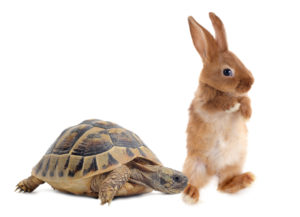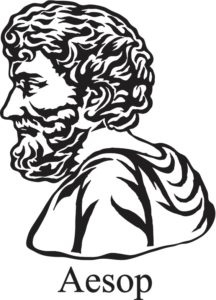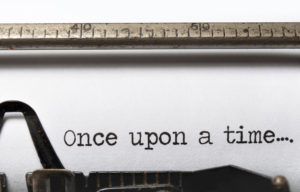Telling a Life Science Marketing Story
By David Chapin
SUMMARY
VOLUME 9
, NUMER 7
In this issue I’ll explore the fascinating intersection of storytelling and life science marketing. Storytelling is one of the most durable forms of communication. Stories are the original form of memory, of history and of fact transmission. Now, when people with scientific training hear the word “storytelling,” they often think of campfires and ghost stories. But that’s an overly narrow view; storytelling actually has a lot to teach life science marketers about the most effective way to create communications that stick.
I’m going to tell you a story
As I tell you this story, I want you to ask yourself three questions. First, do you recognize this story? Second, when was the last time you heard this story? Third, how similar is my story to the story you remember?
Okay, here we go:
Once upon a time there was a forest. And there were animals living in the forest. There was a tortoise, who was very slow, and there was a hare, who was very fast. And the hare loved to boast about how quickly he could run.
But the tortoise was tired of all this boasting, so he challenged the hare to a race. On the appointed day, all the animals gathered to watch. And so the race began. And the hare ran and ran. And then he stopped and looked behind him to see the tortoise plodding along. And the hare laughed to himself. “I’ve got plenty of time,” he thought. And he went to play in a nearby meadow.

Storytelling in life science marketing can be an incredibly powerful way to build a message that sticks. Aesop’s fable sticks in your mind, despite the erosion of time.
And the tortoise kept on walking at his slow and steady pace.
And as the hare was playing he found some tasty dandelions, so he stopped for a snack.
And the tortoise kept on walking at his slow and steady pace.
And soon the hare was so full that he got sleepy, and he lay down to take a nap in the warm sunshine.
And the tortoise kept on walking at his slow and steady pace.
And finally, the hare woke up with a start. And he heard a celebration in the distance. He got up and ran and ran as fast as he could, but he couldn’t catch up.
So when he got to the finish line, he found that the tortoise, who had been walking all this time, had already crossed the line in first place. All the animals were celebrating and there was cake and balloons for everyone.
And the moral of this story is: slow and steady wins the race.
Three questions about this story
Do you recognize the story? Of course you do. Aesop’s fable of the tortoise and the hare is a classic. Aesop lived from 620-564 BCE; this story has been around for two and a half millennia.
When was the last time you heard this story? My life science marketing team and I frequently use this story as an example during the training we do with our clients. The typical answers to this question follow a bi-modal pattern. The answer is either “decades ago” or “within the last year,” in which case it’s a safe bet that the respondent has young children or grandchildren.
How similar is the story I told to the story you remember? Actually let me split that question into two: Were all the details of the story I told identical to the story you remember? The typical answer is, “No!” For example, most people point out that their story doesn’t have dandelions in it, or a celebration with cake and balloons at the finish line. And somewhat surprisingly, many people don’t remember the fact that the rabbit was boastful, until they’re prompted. Based on the thousands of people we’ve told this story to, I can predict with great confidence that your story incorporated different details.

Some messages are sticky; they remain in our memory for a long time. Life science marketers can look to Aesop to learn how to create sticky messages.
But how about the “big picture”—did the overall flow of the action in your story match the story I told? The answer to that question is almost invariably, “Yes, absolutely.” The main characters are the same, the action is the same, the outcome is the same and the moral is the same.
Based on those answers, here’s one final question: How many times in your life have you heard that story? Be honest and be realistic. You’ve probably heard the moral (“Slow and steady wins the race”) many times, but how often have you heard the entire story, from start to finish? For most people the answer is less than a half-dozen, unless of course it was your child or grandchild’s favorite story.
Why do you remember this story?
If you’re like most people in our life science marketing training events, you last heard this story several decades ago, and only heard it a few times, and yet you remember its big arc exactly. Isn’t that amazing? Obviously, there’s something about this story that is memorable.
Think of it this way: How many stories have you heard in the decades since you last heard the story of the Tortoise and the Hare? How many TV shows have you watched? How many movies have you seen? How many novels have you read? How many TV advertisements—which are mini-stories—have you watched since you last heard Aesop’s fable?
Do you remember all these other stories—these TV shows, movies, novels, ads? No, of course not. Yet you remember Aesop’s fable.
Which brings us to the most important question of all: Why do you remember Aesop’s story, but forget all those others?
Sticky stories
The story of the Tortoise and the Hare is sticky. Why is it so memorable? What makes stories sticky? This is an incredibly important question—especially for life science marketing.

Most people last heard Aesop’s fable more than a decade ago, but they remember it very well. Why is this story so sticky?
Aesop’s fable of the Tortoise and the Hare is prima-facie evidence that some communication is so sticky that it remains in our heads for decades, resisting both the abrasion of time and the constant bombardment of other stories trying to displace it.
What makes stories sticky? If we could figure this out, we might be able to harness our knowledge to craft life science marketing messages that stick. Can you imagine a life science marketing story that was so sticky that people would remember it for decades, after hearing it or seeing it less than a dozen times? That would be pretty powerful, right? Well, that’s exactly what The Tortoise and the Hare represents. A story with sticking power.
Would you like to tell one life science marketing story that would stick for decades? Would you like to run an ad or campaign only a few times and have it be so resonant that your audience would remember the core message for decades? Of course you would.
What makes stories in life science marketing sticky?
To create a sticky life science marketing story, you have to understand the proper way to harness the power of storytelling. But this is not as simple as it seems. You see, a good story can be so compelling that when you read it, you can’t identify what makes it compelling.
What makes Aesop’s fable sticky? Is this fable memorable because it involves a heroic turtle or a fast rabbit? Is it sticky because there are animals that talk? Is it sticky because it’s about a race between the two main characters? No, there are lots of stories that have these specific types of content. So clearly, it’s not the content by itself that makes this story sticky. The components that make this story sticky are in plain sight, if you know where to look, but the story’s compelling nature obscures them.
Lisa Cron, author of Wired for Story; The Writer’s Guide to Using Brain Science to Hook Readers from the Very First Sentence, puts it this way: “…the first job of any good story is to completely anesthetize the part of our brain that questions how it is creating such a compelling illusion of reality.” She goes on: “When a story enthralls us, we are inside of it… and the last thing we’re focusing on is the mechanics of the thing. So it’s no surprise that we tend to be utterly oblivious to the fact that beneath every captivating story, there is an intricate mesh of interconnected element holding it together, allowing it to build with seemingly effortless precision.”
To analyze how to create sticky stories, we’ve got to cover some really important foundational topics. These are crucial to understanding and then harnessing the power of storytelling. If we don’t have this foundational understanding, we’ll be like a lab technician who can sequence DNA, but who has no idea what the results mean or how to use them to identify a druggable target.
So before we can focus on the mechanics of creating sticky stories, we’ve got to visit some foundational topics. Trust me, this will be worth it when we get to creating compelling stories.
Don’t trivialize storytelling

Classifying all stories in the same genus as ghost stories trivializes an important, fundamental part of human culture.
One of the first things I need to do is to put storytelling into context. Many people who believe in rational decision-making hear the word “storytelling” and a clear image comes to mind. They think of sitting around a campfire making s’mores from graham crackers, chocolate bars and toasted marshmallows while listening to ghost stories about a haunted house.
But classifying all stories in the same genus as ghost stories trivializes an important and fundamental part of human culture. Storytelling is intertwined with human evolution. Storytelling runs deep in culture. This is true regardless of which culture you study. Human societies across the globe have been telling stories for thousands of years. But when someone mentions “storytelling” most people think only of entertainment, the latest blockbuster movie, binge-worthy TV series or bestselling pot-boiler novel. This approach overlooks the power that storytelling brings to communication in general, and specifically to marketing—which of course is nothing more than communication with a specific purpose.
We’re soaked in story
Stories show up in many forms beyond movies and television shows: novels, plays, songs. Even the news is presented as a series of “stories,” on TV, the radio and in print. Story is embedded in our culture.
We’re so steeped in story that when we’re not consuming stories, we make them up ourselves. Our dreams often take the form of a narrative, even if it’s a non-rational one that leaves us scratching our head in the morning.
We don’t invent stories only when we’re asleep. Jonathan Gottschall, the author of The Storytelling Animal says, “Clever scientific studies involving beepers and diaries suggest that an average daydream is about fourteen seconds long and that we have about 2000 of them per day. In other words, we spend about half our waking hours–one third of our lives on earth–spinning fantasies.”[ii]
Story surrounds us. Most jokes are stories. Even a scientific paper can read like a story as it follows the standard structure: Title, Abstract, Introduction, Methods, Results, Discussion.

We’re deluged by story. It surrounds us: movies, TV programs, ads on radio and TV, novels, plays, songs; we’re soaked in story.
Science uses story. Jonathan Gottschall stated in an interview: “Scientists are telling stories, too. That’s what a hypothesis is. You have the question, and you make up a story about how to account for the phenomenon. The advantage that sciences have over the humanities (one of them) is that science has methods for helping winnow down the field of competing hypotheses.”[iii]
No matter what discipline you examine, humanity is soaked in story. We’re so surrounded by story that often we don’t recognize it.
Storytelling is a popular topic
Search Amazon.com for books on storytelling and you’ll see more than one thousand separate entries. Same for screenwriting. Search for “books on writing” and you’ll find more than 60,000 entries. There’s a lot of advice on storytelling because there is lots of money to be made from a good story in movies, novels, theater and even song.
And the topic has grown in popularity lately. These NGram plots show the prevalence of the words “storytelling” and “narrative” in books, graphed by year. These data from Google only go through the year 2008, but you don’t need a PhD in statistics to see the trend.
Figure 1: The prevalence of the word “storytelling” in books has increased drastically over the last 7 decades.
And here is a plot covering the same years, for the term “narrative.”
Figure 2: The prevalence of the word “narrative” in books has followed a similar pattern. The data show a drastic increase.
These data reveal a huge rise in awareness and interest in storytelling and narrative. More and more people are aware of the power of stories. This interest is shared by more than just individuals; organizations are engaging as well. The Alan Alda Center for Communicating Science at Stony Brook University in New York is devoted to empowering “scientists and health professionals to communicate complex topics in clear, vivid, and engaging ways.” Given Alan Alda’s involvement, it’s not surprising that one of the ways they do this is through the power of story.
Stories are universal
Stories began long ago; the use of stories certainly predates writing. Stories have been with us for millennia. The fact that storytelling has survived for so long suggests that there is something important about stories and storytelling.

The fact that storytelling has survived for so long suggests that there is something crucially important about stories and storytelling.
Stories are universal; all cultures have stories, and many of these stories from around the world share significant similarities. The stories from widely dispersed cultures (ones that shouldn’t have had any contact with each other, except in the distant, distant past) are so similar that it suggests that there is something uniquely human about stories. Stories thrive and grow in all cultures, and the fact that they have such similarities to each other suggests that there are common evolutionary “pressures” on stories, which results in the similarities.
All cultures have stories featuring the most common archetypes, such as the hero, who fights against great odds and emerges from his trials having been changed, the lover, who is tested and is willing to sacrifice him/herself for the greater good, the ruler, who must decide between self-interest and the greater good, the jester, who speaks truth to power, even though it may result in his banishment, and many, many others.
If stories are universal—common to all cultures—and if humans have carried stories with them for millennia, then what are stories for? What roles do they play? What functions do stories have?
What are stories for?
Stories are so widely popular because storytelling is so powerful. But what is the source of storytelling’s power? What exactly are stories for? Are they to help the storyteller cut through the noise that surrounds their audience? Are they to help the audience pay attention? Are they primarily to communicate facts in a memorable way? Do they act as virtual simulators for life, enabling the listener to experience specific situations without putting ourselves at risk by actually participating in those same situations? Or are they just hitchhikers, taking advantage of the fact that our brains have evolved to be excellent at pattern recognition by offering up patterns to recognize?
I entered the topic of storytelling in the life sciences by looking closely at life science marketing case studies. And after I’ve dissected storytelling in greater detail, I’ll be able to come back to the topic of case studies, where it should be no surprise that we’ll use our storytelling skills to create compelling case studies.
But because the topic of storytelling is so extensive, I’ve got a one more important topic to cover first. In my next issue I’ll explore a fundamental question: What are stories for? Examining the different hypotheses that might answer this question will help us develop some important insights into the power of stories, such as the hardwiring of the brain that makes them susceptible to being hijacked. Once we understand this, we can tackle the topic of what makes stories work, and we’ll then be able to craft our own stories that stick.
[i] Cron, Lisa Wired for Story. The Writer’s Guide to Using Brain Science to Hook Readers from the Very First Sentence. Berkeley: Ten Speed Press, 2012. 4. Print
[ii] Gottshall, Jonathan The Storytelling Animal. How stories make us human. Boston: Mariner, 2012. 11. Print.
[iii] https://www.edge.org/conversation/jonathan_gottschall-the-way-we-live-our-lives-in-stories
The Marketing of Science is published by Forma Life Science Marketing approximately ten times per year. To subscribe to this free publication, email us at info@formalifesciencemarketing.com.
David Chapin is author of the book “The Marketing of Science: Making the Complex Compelling,” available now from Rockbench Press and on Amazon. He was named Best Consultant in the inaugural 2013 BDO Triangle Life Science Awards. David serves on the board of NCBio.
David has a Bachelor’s degree in Physics from Swarthmore College and a Master’s degree in Design from NC State University. He is the named inventor on more than forty patents in the US and abroad. His work has been recognized by AIGA, and featured in publications such as the Harvard Business Review, ID magazine, Print magazine, Design News magazine and Medical Marketing and Media. David has authored articles published by Life Science Leader, Impact, and PharmaExec magazines and MedAd News. He has taught at the Kenan-Flagler Business School at UNC-Chapel Hill and at the College of Design at NC State University. He has lectured and presented to numerous groups about various topics in marketing.
Forma Life Science Marketing is a leading marketing firm for life science, companies. Forma works with life science organizations to increase marketing effectiveness and drive revenue, differentiate organizations, focus their messages and align their employee teams. Forma distills and communicates complex messages into compelling communications; we make the complex compelling.
© 2024 Forma Life Science Marketing, Inc. All rights reserved. No part of this document may be reproduced or transmitted without obtaining written permission from Forma Life Science Marketing.

